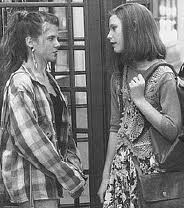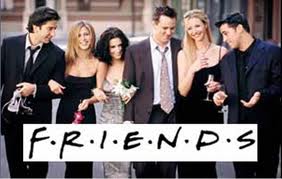“Like Newborn Puppies”
 I’ve written before about vampire and werewolf boyfriends—a la Twilight, 90210, and My So-Called Life. And I’ve written about girlfriends, primarily within an athletic context. Most recently, I wrote about the Romeo-and-Juliet-esque friendship that I shared in middle and high school with Leah, whose parents severely limited her social outlets.Â
I’ve written before about vampire and werewolf boyfriends—a la Twilight, 90210, and My So-Called Life. And I’ve written about girlfriends, primarily within an athletic context. Most recently, I wrote about the Romeo-and-Juliet-esque friendship that I shared in middle and high school with Leah, whose parents severely limited her social outlets.Â
But until reading “My Rayannes†by Emma Straub — http://www.theparisreview.org/blog/2011/01/24/my-rayannes/ — it hadn’t occured to me how little I’ve written about those very tumultuous, passionate, all-consuming adolescent female relationships. I, too, fondly remember watching My So-Called Life as a high school sophomore, during the show’s short-lived run. I still wonder what would have happened to introspective Angela Chase, troubled Rayanne Graf, and that Vampire Boyfriend Jordan Catalano.
Maya was my Rayanne. She was bright, creative, and intelligent. And somehow dangerous. She had an air of edginess—of experience—that I just didn’t. I fell hard for her during the transition between freshman and sophomore year of high school, being completely awed by her ethereal appearance and attitude. She didn’t have a drinking problem like her My So-Called Life counterpart, but she did introduce me to a number of vices one damp October night early in tenth grade. In fact, she regularly opened my eyes to independent films, grunge bands, and the art of subtle pretention. We were a study in yin and yang—she being waifish and artsy, me athletic and wholesome. She dyed her hair outrageous colors with Manic Panic and lunched on Annie’s organic macaroni and cheese. I secretly (or not-so-secretly) loved corn-fed American boys who played sports and did their homework.Â
Maya had her fair share of flaws, like any teenage girl including myself. She had some bullying tendencies, despite her talk of open-mindedness. Deep down, I think that she held on to some insecurities like all of us did (and probably still do), despite maintaining a façade of confidence. She was generally judgmental of anything that she perceived as ordinary or conventional. I often felt like I needed to hide those very present parts of myself.Â
In the pilot of My So-Called Life, Angela dyes her blonde hair a deep crimson, explaining that Rayanne says “her hair was holding her back.â€Â The change shocks her parents, her teachers, her former-friend Sharon, and the geeky childhood neighbor Brian. What’s happened to the innocent Angela that they knew?
While I didn’t dye my hair for Maya, I remember changing like a chameleon for her in more than a few ways. At times it was exciting and eye-opening to try on a new identity; to wear Birkenstocks with hippie skirts and listen to Liz Phair. But it was also alienating. I wasn’t entirely sure who I was yet, and experimenting with this new character of the alterna-Colleen was always for the benefit of Maya and her extended circle of friends. Who was that girl? Ironically, I’m grateful for having had that experience. In some ways it helped me figure out who I was, in the way that you can sometimes determine the definition of a word by recognizing what it doesn’t mean; by examining its antonym. But this play-acting was never comfortable. It never sat quite right on my shoulders. It felt like I was wearing an old Halloween costume that I’d long-since overgrown, or one that had never fit me to begin with.
I didn’t do this consciously, and by senior year I’d grown up enough to figure out that my real persona fell somewhere in between the sports crew and the artsy, brainy clique. I was lucky enough to attend a school and live in a town where you could be both, so I was a floater. I was also active in student government and theater, dabbling all over the place with different friends and activities, and eventually I realized that I could embrace my ability to code-switch. It was fun to wear different hats, and I didn’t have to apologize for it or define a specific identity.
My Rayanne was an entry point into one of those circles, and I loved her for that. I remember many a snowy day lounging on Maya’s bed or on the couch in her room, lit only by giant candles, listening to Simon and Garfunkle and memorizing the (I perceived) worldly statements that came out of her mouth. As Straub puts it, “Teenage girls curl up together like newborn puppies, painting one another’s toes as if they were licking one another’s ears.â€Â Indeed, Maya and I would snuggle up for warmth and hold hands, defining ourselves through the company we kept. We’d physically announce our relationship—our closeness—by linking arms in the hallway and exchanging locker combinations.  Teens are so much like that anyway, no matter what generation they belong to. Also like newborn puppies, their developing personalities are shaped, morphed, and informed by their peers. When we’re little, our entire worlds center on our parents or immediate family/guardians. In our teen years, though, that scope changes. We become dependent on our friends, and those relationships—especially for girls, it seems—eclipse all else. Our friendships dictate how we dress, the classes we take, the activities we adopt, our vernacular, our choices, our behaviors.    Â
Maya and I are still friends (or, at least, Facebook says so), though we aren’t by any means close. The last time I saw her she was exuberant and genuinely warm, and I quickly appreciated her charming husband. I still admired her fashion sense, though it had clearly matured and become a bit gentler, and I was happy to engage in the customary catching-up conversation. As adults, the relationship was so easy, so grown-up. We were appropriately affectionate. We weren’t hopelessly, desperately in love with each other, but we shared a mutual respect that felt like something close to relief.  My husband was surprised that he hadn’t met Maya before, or that he hadn’t at least heard more about her, so natural was our interaction. I shrugged when he brought it up, explaining, “We were really close back then. But it was a teen thing. A phase, I guess.â€
And yes, it was. But that doesn’t make it any less important. And maybe it was me, but ten years later she still looked just the same.
